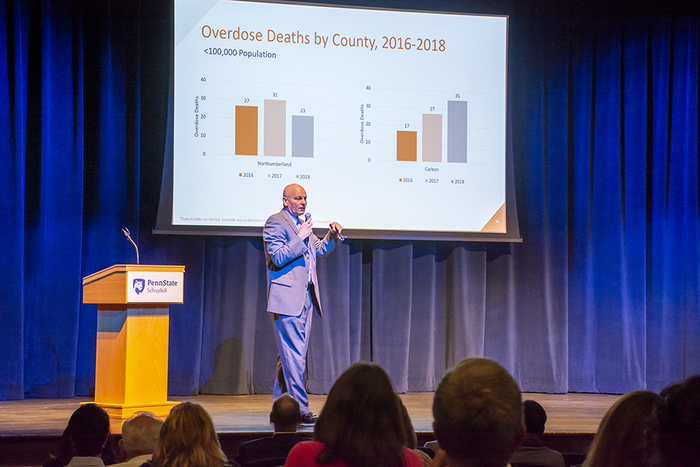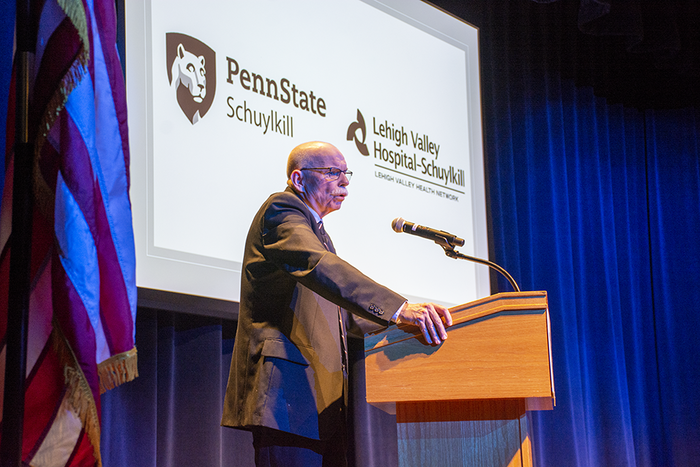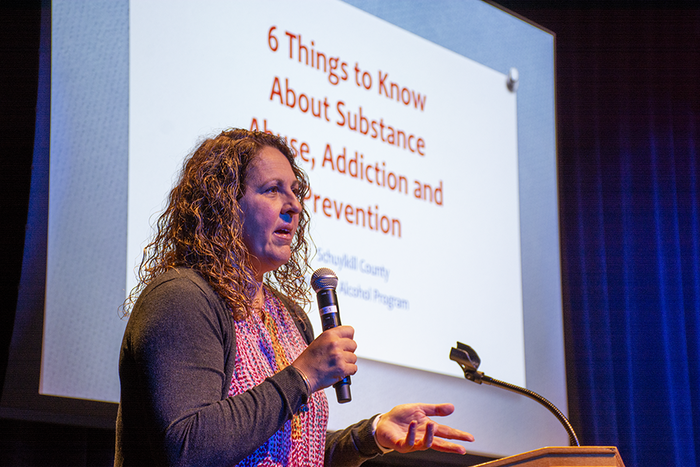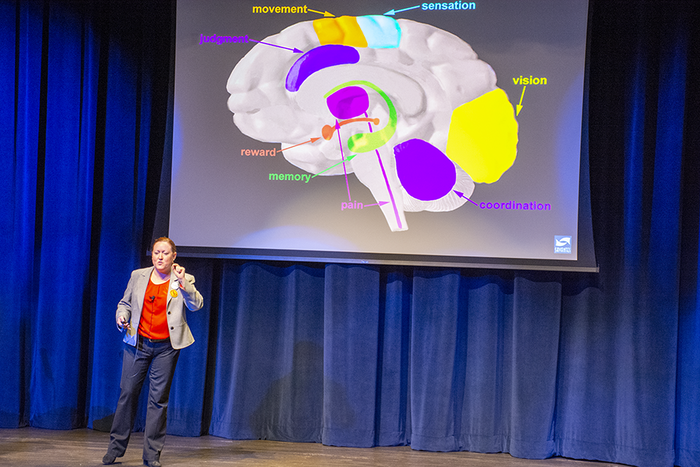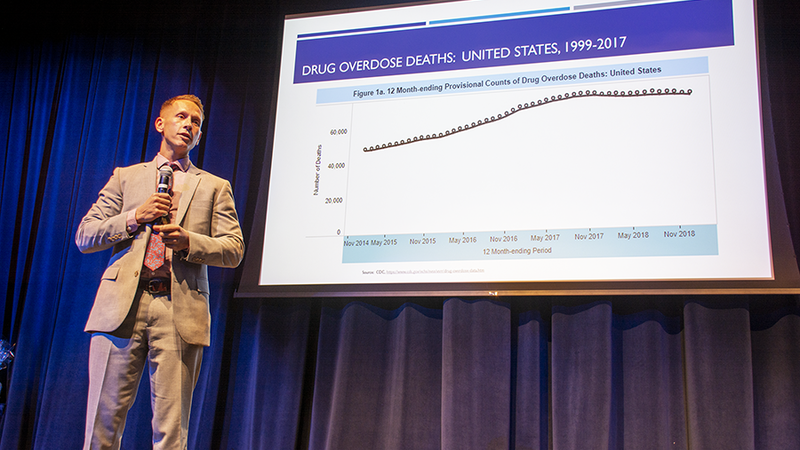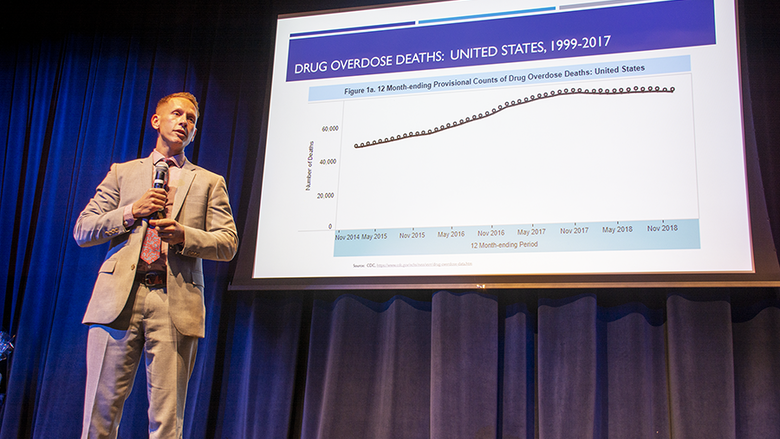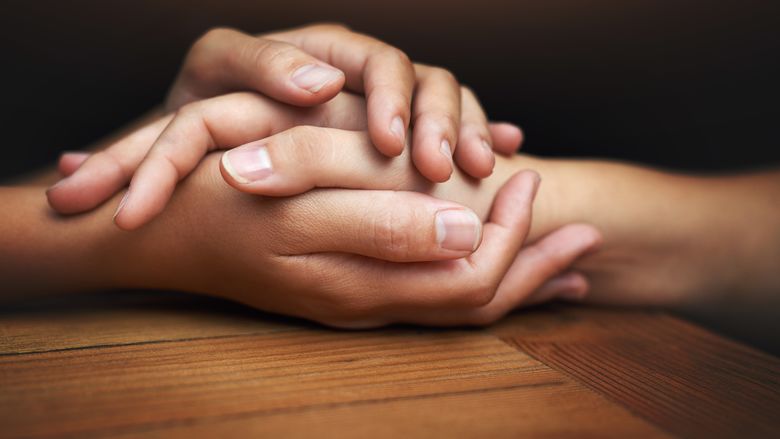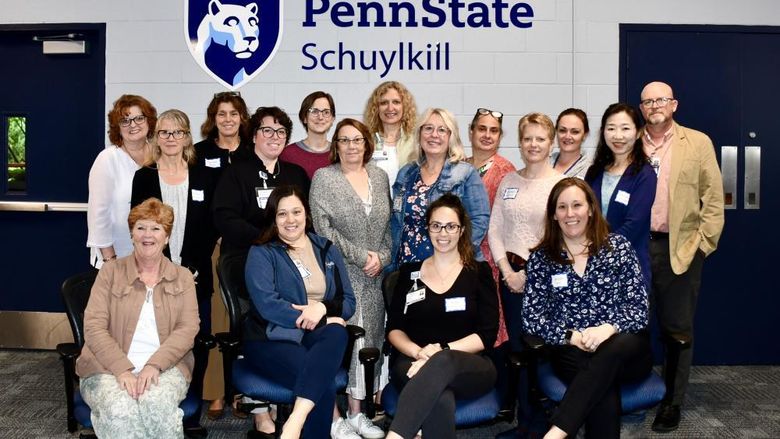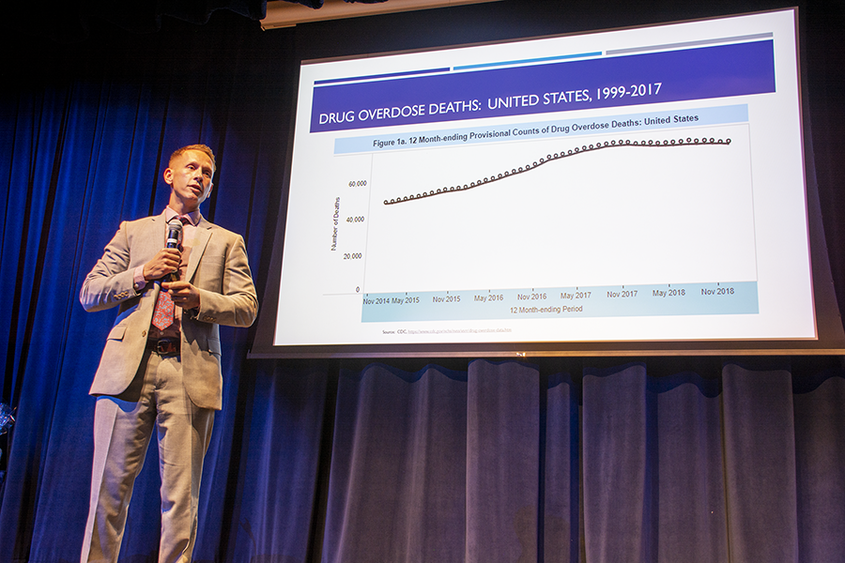
In his keynote address, Dr. Glenn Sterner, assistant professor of Criminal Justice at Penn State Abington, provided an overview of the opioid crisis from the early 2000s until today. “This is a disease. This is not a moral failing,” he said.
SCHUYLKILL HAVEN, Pa. — Penn State Schuylkill and Lehigh Valley Hospital – Schuylkill collaborated to present “Opioids: The Crisis Next Door,” a free conference held on campus Sept. 19 that detailed the facts and signs of addiction, as well as the resources available to help community members affected by the epidemic. The conference’s 200 attendees heard from a variety of addiction and behavioral health experts throughout the day-long event.
Understanding the Opioid Crisis
In his keynote address, Glenn Sterner, assistant professor of criminal justice at Penn State Abington, provided an overview of the opioid crisis from the early 2000s until today. He explained the difference between opiates, which are naturally derived, and opioids, which are synthetic or chemically altered; spoke about where these drugs come from; and explored the ways in which addictions develop. Perhaps most importantly, however, Sterner spoke about the stigma of addiction, and how the stigma surrounding opioid abuse acts as a barrier to treatment.
“This is a disease. This is not a moral failing,” he said. “[Opioid abuse] disrupts our families, disrupts our communities."
Sterner explained that, to combat the problem, community engagement, support and understanding are essential.
Sterner concluded his address by sharing helpful resources, including one he developed himself. The Share Your Opioid Story initiative offers addicts and their loved ones the opportunity to tell the real stories behind the opioid crisis. By sharing these true stories, the initiative intends to inspire hope in others, dispel myths and decrease stigma.
“When we address this in a comprehensive way – when we work across all of our capacities in our communities – we can do this," he said.
Following Current Drug Trends
Schuylkill County District Attorney Michael O’Pake spoke next, offering the crowd a legal perspective on controlling the opioid crisis. O’Pake spoke about the crime in Schuylkill County, noting that almost every crime has an element of drug abuse to it. Some people, he explained, steal for drug money; others neglect their children while high. Soberingly, he admitted that he cannot stop the flow of drugs into the county, but explained that “my goal is to lessen the impact of drugs in Schuylkill County.”
O’Pake talked about the success of Schuylkill’s Drug Treatment Court, a 14-month program that has graduated three classes. This program assists people in recovery by providing them with housing, supporting their employment, and fostering their relationships to maintain the road to recovery.
“The only way to beat this problem is through education, treatment and enforcement,” O’Pake said. “Together, those three things will lessen the impact of drugs in Schuylkill County.”
Seeking Counseling and Identifying Resources
Bill Rowan, program director of the Center for Counseling Services at Lehigh Valley Hospital – Schuylkill, spoke about counseling and resources pertinent to the disease of addiction. He mirrored the sentiments of speakers before him while also touching on the personal responsibility inherent to treating any disease, saying, “You are not responsible for a disease; you are responsible for recovery from that disease.”
Rowan challenged attendees to see the crisis from a different perspective, saying, “We have to change the conversation about what it means to have a substance-abuse disorder diagnosis.”
Like a diabetic should eat healthful food and take insulin, Rowan encouraged opioid users to take the reins of their recovery.
Addiction Prevention and How to Recognize the Hidden Signs of Drug Abuse
Diane Rowland, prevention services coordinator at the Schuylkill County Drug and Alcohol Program, shared information about addiction prevention and informed attendees how to recognize the signs of drug abuse. Her methods include “knowing your person” – his or her appearance, attitude, typical behaviors and activities.
When someone strays from normal patterns and habits, Rowland recommended looking at “The 4 Ms,” which she describes as “Mood, Mess, Money and Missing (possessions, presence).” Addiction changes individuals’ moods, and usually leaves their lives a mess, she explained. Addiction also affects the individual’s and his or her loved ones’ money, and loved ones also often find things missing — whether it be the addicted person’s presence or their own possessions.
Rowland concluded that knowing the signs of drug abuse helps prevent catastrophe, emphasizing, “The sooner a drug problem is recognized, the easier it is to get help.”
Integrated Team Approaches to Recovery and Wellness
Dr. Gillian Beauchamp, emergency medical physician and toxicologist at the Lehigh Valley Health Network, delivered the final expert presentation of the day. As an emergency medical physician, Beauchamp is no stranger to cases of overdose, and she spoke about how her team works in concert to help show addicts the road to recovery and wellness.
For Beauchamp, the conversation leading to recovery begins at the scene of the overdose, continues in the ambulance ride to the hospital, and progresses through the remainder of the individual’s hospital stay.
“The idea,” said Beauchamp, “is that hope happens at a place like a hospital. It happens in an emergency department.”
Much of Beauchamp’s presentation focused on the positive energy necessary for an individual to choose recovery, especially noting the importance of compassion from health care professionals.
"One huge message that is really important today is hope,” she said, citing examples from the other presenters. “Hope really needs to be a big part of how we talk with people in recovery, and their families.”
The Human Cost of Addiction
Perhaps the most powerful portion of the day, the conference closed with testimonials from people who have experienced the crisis firsthand. Some lost children, others gained custody of their grandchildren. All made a point to shed the jacket of anonymity to dispel the stigma surrounding the disease.
Carmen McGlothlin, founder of Facebook support group Grandparents Raising Grandchildren, shared a poignant message about her own experience. McGlothlin’s grandchildren are essentially orphaned, their mother dead from an overdose and their father – McGlothlin’s son – incarcerated.
“This is a multigenerational epidemic,” she said, underscoring that it “not only affects the addicts themselves, but the families who love them.”
This is the human cost of addiction – the people, places and things addicts lose while struggling to manage their substance use disorder.
'Many Hands Make Light Work'
Penn State Schuylkill and Lehigh Valley Hospital – Schuylkill are uniquely positioned to bring expert speakers and professional help to Schuylkill County residents, as evidenced by this opioid conference. Through collaboration, these institutions provided a valuable community service.
The conference’s most important takeaway was that everyone can play a role in mitigating this crisis. In the old Pennsylvania Dutch axiom, shared by Penn State Schuylkill Chancellor Patrick M. Jones when welcoming everyone to the conference, “Many hands make light work. Only together can we address this epidemic.”
View Glenn Sterner's presentation:
